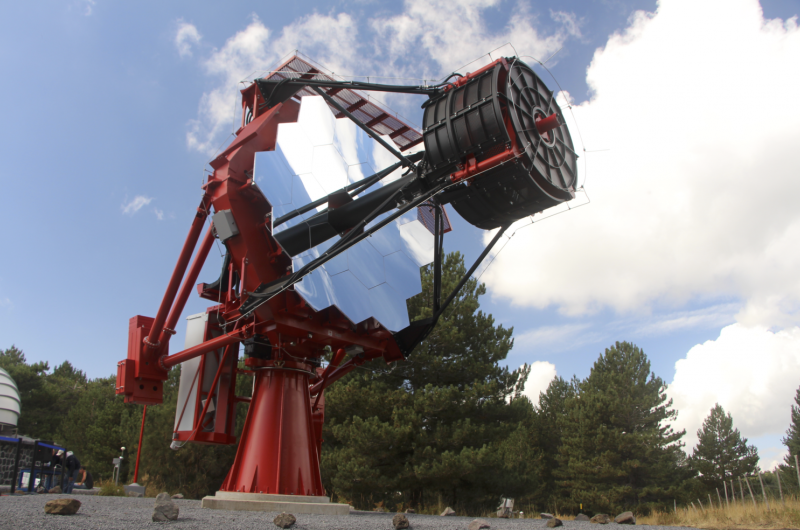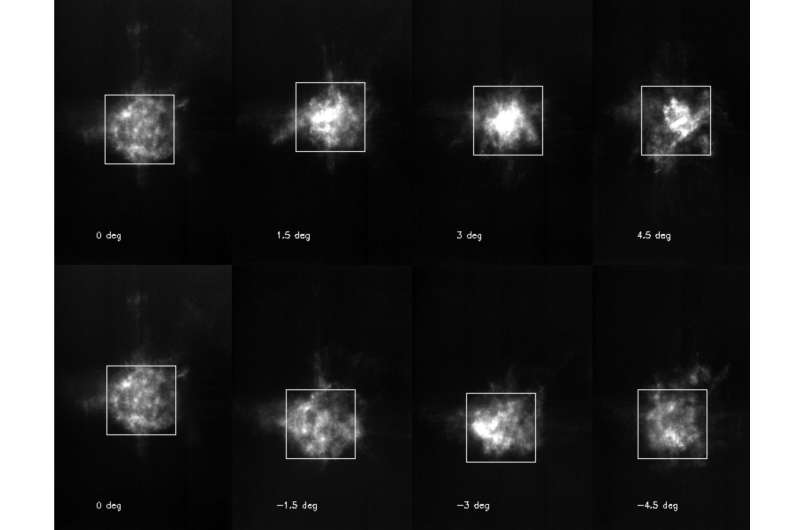Prototype telescope demonstrates viability of novel Schwarzschild-Couder design

In October 2016, the ASTRI telescope prototype, (Image 1) a novel, dual-mirror Schwarzschild-Couder telescope design proposed for the Cherenkov Telescope Array (CTA), passed its biggest test yet by demonstrating a constant point-spread function of a few arc minutes over a large field of view of 10 degrees.
Three classes of telescope types are required to cover the full CTA very-high energy range (20 GeV to 300 TeV): Medium-size telescopes will cover CTA's core energy range (100 GeV to 10 TeV) while the large-size telescopes and small-size telescopes (SSTs) will extend the energy range below 100 GeV and above a few TeV, respectively.
The ASTRI telescope is one of three proposed SST designs being prototyped and tested for CTA's southern hemisphere array. The ASTRI telescope uses an innovative dual-mirror Schwarzschild-Couder configuration with a 4.3 m diameter primary mirror and a 1.8 m monolithic secondary mirror. In 1905, the German physicist and astronomer Karl Schwarzschild proposed a design for a two-mirror telescope intended to eliminate much of the optical aberration across the field of view. This idea, elaborated in 1926 by André Couder, lay dormant for almost a century because it was considered too difficult and expensive to build. In 2007, a study by Vladimir Vassiliev and colleagues at the University of California Los Angeles (UCLA) demonstrated the design's usefulness for atmospheric Cherenkov telescopes.
The ASTRI prototype, the first Schwarzschild-Couder telescope to be built and tested, was inaugurated in September 2014 and has been undergoing testing at the Serra La Nave observing station on Mount Etna in Sicily ever since. The technical challenges of the design were overcome by recent advances, particularly in dual-mirror technology, making it a feasible implementation for the observation of Cherenkov light.
Image 2 shows Polaris as observed by ASTRI with different offsets from the optical axis of the telescope. The recorded images have approximately the same angular size, each one from a different observational direction in the field of view (from 0 to 4.5 degrees from each side with respect to the central optical axis). These images show that the optical point-spread function of the telescope is approximately constant across the full field of view. This information will allow scientists to reconstruct the direction of gamma-ray photons emitted from celestial sources.
"This is also the first time that a Cherenkov telescope with two focusing mirrors has been completely characterized from the opto-mechanical point of view," said Giovanni Pareschi, astronomer at the INAF-Brera Astronomical Observatory and principal investigator of the ASTRI project. "This is an important result, because it allows us to move immediately to the next step—to mount a Cherenkov camera by December 2016 and observe the first gamma-ray light with ASTRI."

The ASTRI project is led by the Italian National Institute of Astrophysics (INAF) with the collaboration of a number of Italian universities, the Italian National Institute of Nuclear Physics (INFN), Universidade de São Paulo in Brazil and North-West University in South Africa.
The SSTs will outnumber all the other telescopes with 70 spread out over several square kilometres in the southern hemisphere array. Since very high-energy gamma-ray showers (between a few TeV and 300 TeV) produce a large amount of Cherenkov light, it is sufficient to build telescopes with small mirrors to catch that light. The SSTs' wide coverage and large number, spread over a large area, will improve CTA's chances of detecting the highest energy gamma rays. The Schwarzschild-Couder design is being used in two additional CTA prototypes (the SST-2M GCT and the SCT), but the ASTRI is the first to conclusively demonstrate the viability of the system.
Provided by Cherenkov Telsecope Observatory





















